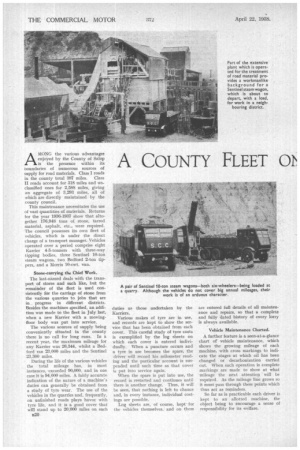A COUNTY FLEET Ols
Page 58

Page 59

If you've noticed an error in this article please click here to report it so we can fix it.
QUARRYING WORK AMONG the various advantages enjoyed by the County of Salop is the presence within its boundaries of numerous sources of supply for road materials. Class I roads in the county total 387 miles. Class II roads account for 318 miles and unclassified ones for 2,588 miles, giving an aggregate of 3,293 miles, all of which are directly maintained by the county council.
This maintenance necessitates the use of vast quantities of materia/s. Returns For the year 1936-1937 show that altogether 176,948 tons of stone, tarred material, asphalt, etc., were required. The council possesses its own fleet of vehicles, which is under the direct charge of a transport manager. Vehicles operated over a period comprise eight Karrier 4-5-tonners with three-way tipping bodies, three Sentinel 10-ton steam wagons, two Bedford 2-ton tippers, and a Morris 10-cwt. van.
Stone-carrying the Chief Work.
The last-named deals with the transport of stores and such like, but the remainder of the fleet is used consistently for the carriage of stone from the various quarries to jobs that are in progress in different districts. Besides the machines specified, an addition was made to the fleet in July last, when a new Karrier with a movingfloor body was put into service.
The various sources of supply being conveniently situated in the county there is no call for long runs. In a recent year, the maximum mileage for any }Carrier was 26,344, whilst a Bedford ran 23,000 miles and the Sentinel 23,300 miles.
During the life of the various vehicles the total mileage has, in most instances, exceeded 90,000, and in one case it is 94,000 miles. A fairly accurate indication of the nature of a machine's duties can generally be obtained from a study of tyre wear. The use of the vehicles in the quarries and, frequently, on unfinished roads plays havoc with tyre life, and it is a good cover that will stand up to 20,000 miles on such E20 duties as those undertaken by the Karriers.
Various makes of tyre are in use, and records are kept to show the service that has been obtained from each cover. This careful study of tyre costs is exemplified by the log sheets on which each cover is entered individually. When a puncture occurs and a tyre in use becomes the spare, the driver will record his milometer reading and the particular account is suspended until such time as that cover is put into service again.
When the spare is put into use, the record is restarted and continues until there is another change. Thus, it will be seen, that nothing is left to chance and, in every instance, individual costings are possible.
Log sheets are, of course, keptfor the vehicles themselves, and on them are entered full details of all maintenance and repairs, so that a complete and fully dated history of every lorry is always available.
Vehicle Maintenance Charted.
A further feature is a seen-at-a-glance chart of vehicle maintenance, which shows the growing mileage of each machine, with cross markings to indicate the stages at which oil has been changed or decarbonization carried out. When each operation is complete markings are made to show at what mileage the next attention will be required. As the mileage line grows so it must pass through these points which thus act as reminders.
So far as is practicable each driver is kept to an allotted machine, the object being to encourage a sense of responsibility for its welfare. Three hours are allowed weekly for cleansing and greasing, which the drivers undertake themselves, and, especially when the rough work performed is taken into account, it is obvious that the motors are remarkably well maintained.
All the men hold certificates of the National Safety First Association, and there is keen competition among them for the honour of securing the annual award which goes to the man with the best-kept outfit.
Modern Central Depot.
Since the establishment of the fleet, a central depot has been built at Meole Brace, on the outskirts of Shrewsbury, and it has modern offices, stores, and other accommodation. Repairs (with the exception of such work as rebores) and maintenance are carried out at this depot.
From an inspection of the machines and an examination of the conditions under which they operate it would seem that the county council fleet has•proved its efficiency in handling the regular and heavy work which is the natural lot of the Roads and Bridges Department.


































































































